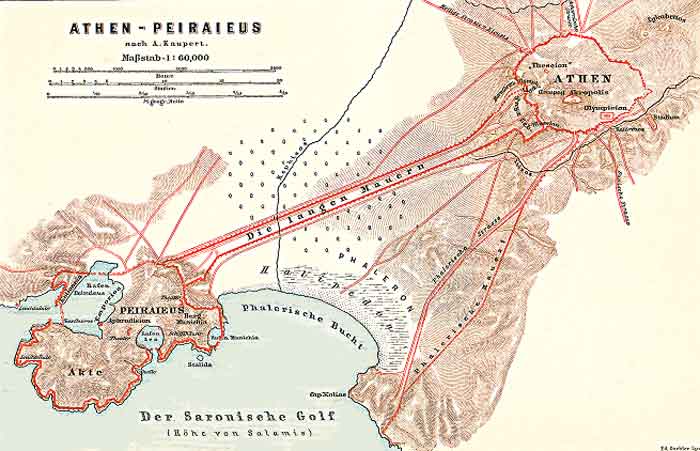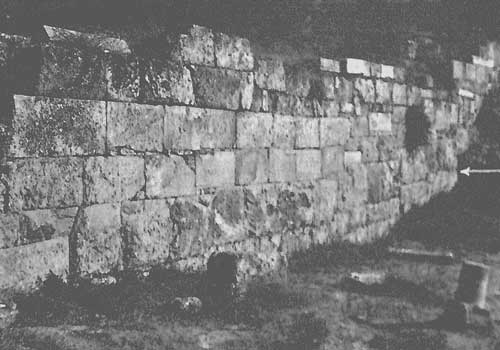.

The Long Walls generally refers to the walls connecting Athens to its port at Piraeus which were constructed in the mid 5th century BC, destroyed by the Spartans in 404 BC after Athens' defeat in the Peloponnesian War, and rebuilt again with Persian support during the Corinthian War. They were a key element of Athenian strategy, since they provided the city with a constant link to the sea and prevented it from being besieged by land alone.
It can also refer to similar walls built at other locations in Greece, most notably at Megara, but these walls were less historically significant, and thus are less frequently referred to.

The 5th century BC fortification of Athens (red lines) superimposed on a recent astronaut photo. Also shown the river beds in ancient times (cyan lines), the new river bed (dotted cyan line), the ancient roads coinciding with existing ones (yellow dotted lines) and the Phaleron coastline at ancient times (blue line). Enlarge
Building of the Long Walls
The first walls at Athens were built shortly following the end of the Persian Wars, during which the city had been burned by the Persians prior to the battle at Salamis. Before that time, Athens had been protected only by the fortifications of the acropolis. At the time, Sparta objected to the building of the walls, but Themistocles was dispatched to soothe the Spartans, and the construction went ahead.
In 461 BC, construction was begun on an expansion to the walls, which would connect Athens to its port at Piraeus. Completed in 457 BC, these were the Long Walls, and they ensured that Athens could not be cut off from supplies so long as it controlled the sea.

Part of the Themistoclean walls
The Long Walls in Athenian strategy
The building of the Long Walls reflected a larger strategy that Athens had come to follow in the early 5th century. Unlike most Greek city states, which specialized in fielding hoplite armies, Athens, since the time the building of her first fleet during a war with Aegina in the 480s BC, had focused on the navy as the center of its military. With the founding of the Delian League in 477 BC, Athens became committed to the long term prosecution of a naval war against the Persians. Over the following decades, the Athenian navy became the mainstay of an increasingly imperial league, and Athenian control of the sea allowed the city to be supplied with grain from the Hellespont and Black Sea regions.
With the building of the Long Walls, Athens essentially became an island within the mainland, in that no strictly land based force could hope to capture it. (In ancient Greek warfare, it was all but impossible to take a walled city by any means other than starvation and surrender.) Thus, Athens could rely on her powerful fleet to keep her safe in any conflict with other cities on the Greek mainland.
This strategy was first put to the test in Athens' first conflict with the Peloponnesian states, running from 445 BC to 440 BC. In this war, the Athenians were able to protect and supply their city behind the long walls, but made the mistake of marching out to face a Spartan army that was ravaging the fields of Attica, and were defeated in battle. The war ended with the Athenians losing the territory they had acquired on the Greek mainland, and concluding a 50 year peace with Sparta.
The walls in the Peloponnesian War
In Athens' great conflict with Sparta, the Peloponnesian War of 432 BC to 404 BC, the walls came to be of paramount importance. Pericles, the leader of Athens from the start of the war until his death in 429 BC, based his strategy for the conflict around them. Knowing that the Spartans would attempt to draw the Athenians into a land battle by ravaging their crops, as they had in the 440s, he commanded the Athenians to remain behind the walls and rely on their navy to win the war for them. As a result, the campaigns of the first few years of the war followed a consistent pattern: The Spartans would send a land army to ravage Attica, hoping to draw the Athenians out; the Athenians would remain behind their walls, and send a fleet to sack cities and burn crops while sailing around the Peloponnese. The Athenians were successful in avoiding a land defeat, but suffered heavy losses of crops to the Peloponnesian raids, and their treasury was weakened by the expenditures on the naval expeditions and on import of grain. Furthermore, a plague ravaged the city in 430 BC and 429 BC, with its effects being worsened by the fact that the entire population of the city was concentrated inside the walls.
The Athenians continued to use the walls for protection through the first phase of the war until the seizure of Spartan hostages during the Athenian victory at Pylos. After that battle, the Spartans were forced to cease their yearly invasions, since the Athenians threatened to kill the hostages if an invasion was launched.
In the second phase of the war, the walls again became central to the strategy of both sides. The Spartans occupied a fort at Decelea in Attica in 413 BC, and placed a force there that posed a year-round threat to Athens. In the face of this army, the Athenians could only supply the city by sea. The Long Walls, and the access to a port that they provided, were by now the only thing protecting Athens from defeat. Realizing that they could not defeat the Athenians on land alone, the Spartans turned their attention to constructing a navy, and throughout the final phase of the war devoted themselves to trying to defeat the Athenians at sea. Their eventual success, in the victory at Aegospotami, cut the Athenians off from their supply routes and forced them to surrender. One of the most important terms of this surrender was the destruction of the long walls, which were dismantled in 404 BC.
Rebuilding of the Long Walls
Following their defeat in 404, the Athenians quickly regained some of their power and autonomy, and by 403 BC had overthrown the government that the Spartans had imposed on them. By 395 BC, the Athenians were strong enough to enter into the Corinthian War as co-belligerents with Argos, Corinth, and Thebes against Sparta.
For the Athenians, the most significant event of this war was the rebuilding of the Long Walls. By 395 BC the rebuilding of the fortifications had begun and according to the Athenian admiral Conon, the walls had reached their final stages by 391 BC. In 394 BC, a Persian fleet under satrap Pharnabazus II and Conon decisively defeated the Spartan fleet at the Battle of Cnidus, and, following this victory, Pharnabazus sent Conon with his fleet to Athens, where it provided aid and protection as the Long Walls were rebuilt.
Thus, by the end of the war, the Athenians had regained the immunity from land assault that the Spartans had taken from them at the end of the Peloponnesian War. The rebuilt walls stood for many years, unchallenged, and were never mentioned to have been incorporated in Athens' defense planning until after the 340s BC.
According to Xenophon in Hellenica:
Conon said that if he (Pharnabazus) would allow him to have the fleet, he would maintain it by contributions from the islands and would meanwhile put in at Athens and aid the Athenians in rebuilding their long walls and the wall around Piraeus, adding that he knew nothing could be a heavier blow to the Lacedaemonians than this. (...) Pharnabazus, upon hearing this, eagerly dispatched him to Athens and gave him additional money for the rebuilding of the walls. Upon his arrival Conon erected a large part of the wall, giving his own crews for the work, paying the wages of carpenters and masons, and meeting whatever other expense was necessary. There were some parts of the wall, however, which the Athenians themselves, as well as volunteers from Boeotia and from other states, aided in building.
— Xenophon Hellenica 4.8.7 4.8.8[12]
The Long Walls in the 4th CenturyFrom the Corinthian War down to the final defeat of the city by Philip of Macedon, the Long Walls continued to play a central role in Athenian strategy. The Decree of Aristoteles in 377 BC reestablished an Athenian league containing many former members of the Delian League. By the mid 4th century, Athens was again the preeminent naval power of the Greek world, and had reestablished the supply routes that allowed it to withstand a land-based siege.
From the Corinthian War down to the final defeat of the city by Philip of Macedon, the Long Walls continued to play a central role in Athenian strategy. The Decree of Aristoteles in 377 BC reestablished an Athenian league containing many former members of the Delian League. By the middle of the 4th century, Athens was again the preeminent naval power of the Greek world, and had reestablished the supply routes that allowed it to withstand a land-based siege.
The Long Walls had become obsolete and the length and location of the structures rendered them dangerously vulnerable to the advanced siege techniques of the day. The Athenians began to strengthen their urban defense systems by rebuilding the Long Walls again to be able to withstand contemporary methods of assault in 337 BC. The new walls included attributes such as substructures built of cut blocks and possibly even roofs above the walk-ways.
However, the Athenians were not in a position to use the new Long Walls until Alexander the Great's death in 323 BC. By this time Athens' navy had been crushed in the Lamian War and they became subordinate to the Macedonians and the use of the Long Walls in a naval strategy was ruled out. Macedonian leaders controlled cities on both sides of the Long Walls and they had little use for these fortifications, thus the mid-fourth century Long Walls were never actually employed.[13]
Later history
The walls were still standing at the beginning of the 1st century BC. However, during the First Mithridatic War, the Siege of Athens and Piraeus (87–86 BC) was won by the Roman general Sulla and he destroyed the Long Walls.
| Ancient Greece
Science, Technology , Medicine , Warfare, , Biographies , Life , Cities/Places/Maps , Arts , Literature , Philosophy ,Olympics, Mythology , History , Images Medieval Greece / Byzantine Empire Science, Technology, Arts, , Warfare , Literature, Biographies, Icons, History Modern Greece Cities, Islands, Regions, Fauna/Flora ,Biographies , History , Warfare, Science/Technology, Literature, Music , Arts , Film/Actors , Sport , Fashion --- |
Retrieved from "http://en.wikipedia.org/"
All text is available under the terms of the GNU Free Documentation License

